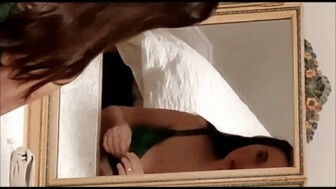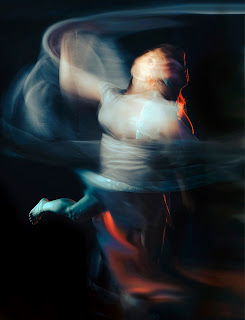Kristen Elizabeth Donoghue-Stanford
One of the most invaluable lessons I learned in my art history classes was the difference between being nude and being naked. Being nude was reserved for goddesses, historical women of significance, etc. Being naked was for the contemporary woman and was scandalous (Manet's Olympia being a prime example of this phenomena).

Growing up in an age where women feared (still fear) the potential release of non-consensual images, I was told to never allow my body to be showcased on film or photograph. It would mark the end to a career I had not even started, potential relationships, and social standing. As a teenager, this logic stood in juxtaposition to the mass images I was consuming in film and media of naked women as commodities to the male gaze. I went to art galleries where I saw rooms filled with naked (actually nude) women. I had to wonder what form of nakedness is correct? Apparently not mine if it was willing.
When I began working with the idea of Performance of Camera, I was extremely hesitant at using my own body because of the gaze I was going to be subjecting it to. It was, however, for this reason that I decided using my own was the only option I had. Because I would never want to put another woman through the experience I was then subjecting myself to.
My performance to camera consistently reminds us of the act of watching. My practice as whole revolves around femininity being rooted in a Gothic existence in relation to its subjugation under patriarchal trauma. Film, specifically horror, is one of the most obvious and evident examples.
The displeasure experienced as a woman watching horror films or any film is the infliction of viewing a woman (and potentially yourself) through the myopic lens of the male gaze. You are forced to watch yourself as a man watching a woman.
Will I claim this occurs always, no. I like to believe there are times where I escape the patriarchal trauma of viewing myself through that lens, but I am overly aware of its presence in the critique of my own body and how it impacts my own views on being seen naked.
The idea of gaze, of watching, I focus on in my performances. I perform to the idea of being watched while refusing to take the responsibility of the looking. As a woman, I have always blamed myself for looking; for the othering subjected upon my person and the abjection. My relationship to the camera here is refusing to take responsibility for your looking, and even my own. Voyeur becomes voyeured becomes voyeur.
Why are you looking?
It is the ultimate question and one I believe we need to ask, even when looking in an art gallery at nude. What makes us decide to watch, to look, to other, to be the voyeur on the edge of the camera. What makes my body the site of abjection? Is it because I'm here, alive and breathing? Not an abstract concept to be adored hundreds of years after my body has decomposed in the ground.
My performances to camera remind myself I'm alive, remind the looker I am, and that underneath it all, clothed or not, I am very much naked, a woman of the contemporary. I never asked you to look.
Lastly, the most important thing I want everyone to remember, to take away from this idea of performing is simply this. That you're never sending a nude, you're always sending a naked.



Your use of the mirror is important, to reflect the voyeur back to themselves : not as a super hero, more as the age-raddled late life Dorian Gray.
ReplyDeleteI found the work of Francesca Woodman inspiring using a mirror as a foil to control her presence or absence at her own volition.
Yes I also began to consider the relationship to Francesca Woodman to this work
DeleteFunny enough I only very recently discovered her work, I believe shortly after I filmed this piece as I'm rather new to film being a part of my artistic practice. Mirrors are a consistent in my practice, however, for their Gothic sentimentality and the reflection they provide of "true self" in the manner of Dorian Gray. The mirror is as important to the voyeur as to the voyeured as to some extent they have to accept they are one in the same - someone is always looking and you are always watching.
DeleteAs a parallel with life drawing, the nude is the idealised body as object, but the life model that breathes, has imperfections in real life is a naked human, and the life class becomes more of act of empathy as those drawing look with care at the body of the model. I suppose the way in which the naked person and their body is then captured as an image, affects whether they then automatically become a nude, frozen and less relatable, or stay naked and vulnerable.
ReplyDeleteI agree, from my time with life drawing, that there is an empathy to be drawn the in the actual act of capturing the figure. But I'm very curious about the boundary that is placed once the actual "living subject" is removed. I think nakedness is set into context. I think within gallery spaces they are always carefully curated to suggest nudity or nakedness - and artists are distinct on it as well. Even past that, is the idea of vulnerability coinciding with exploitation.
DeleteThere is a lot to say relating to this strand of discussion but it would take an age ! One of the things i found very interesting which dealt with the male gaze, possession, voyeurism etc (but without any nudity or nakedness whatsoever and all the more captivating for it) is Hitchcock's film Vertigo. I wrote my M.A. Fine Art dissertation about it (and did a sound piece to accompany the essay) and dealt with themes of desire, the voice and seduction, voyeurism etc and tried also to put the film in its context in late 1950s USA. What a brilliant film, despite the director's often unpleasant behaviour to his actors, especially women. It's a wonderful evocation of desire, obsession, but it also shows us the desire of both the male and female protagonists. I can't really explain in a short comment how many levels this film works on, but it's really revealing about the male gaze and how precarious, seductive and damaging it is. Scottie, the male lead, suffers from Vertigo and looking down sends him into a potentially dangerous loss of consciousness. So his look is not without danger for himself. And for Madeleine/Judy, her look is not just her look at Scottie or the camera, her "look" is her acting of two different characters, Madeleine and Judy (and of course she is also Kim Novak the actress). If any of you haven't seen this film for a long time, please re-visit it. Despite what you can say about Hitchcock, this really is a film about acting, desire and the look (of the camera, the man, the woman, the audience) and also desire and the voice.A brilliant work. Also interesting for me is although you can see worrying aspects of male/female relationships in all this, it's totally mesmerising and watching how the film does this is so instructive.
ReplyDelete